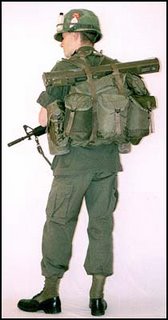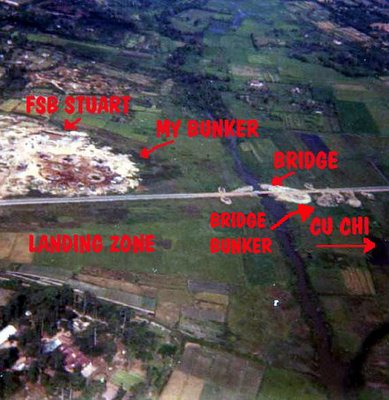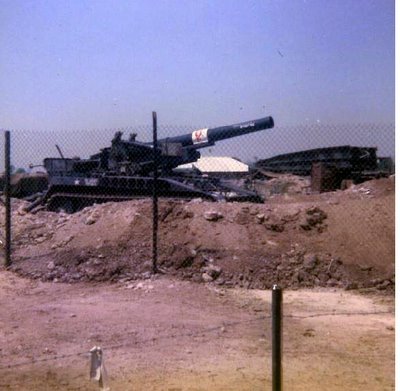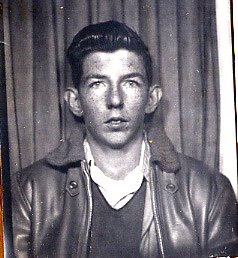 I was drafted into the United States Army on May 6, 1968 at the ripe old age of 19 years, 6 months and 2 days. Government policy at the time was to draft all men into the military at 19 ½ years of age if they hadn’t already joined or had a deferment of some kind. I almost joined earlier that year, but backed out to take my chances with the draft.
I was drafted into the United States Army on May 6, 1968 at the ripe old age of 19 years, 6 months and 2 days. Government policy at the time was to draft all men into the military at 19 ½ years of age if they hadn’t already joined or had a deferment of some kind. I almost joined earlier that year, but backed out to take my chances with the draft.
Although draftees were a small minority (16%) in the U.S. armed forces, they comprised the bulk of infantry riflemen in Vietnam (88% in 1969). They accounted for more than half the army's battle deaths. Because of student and other deferments, the draft and the casualties fell disproportionately upon working-class youths, black and white.
My father and stepmother drove me down to the draft board office in Smithtown NY that morning where I checked in and was put on a bus for the ride to Fort Hamilton in Brooklyn for induction. I remember staring out the window during the ride into Brooklyn wondering if I would live through this adventure and make it back home again after it was all over.
We arrived in at Fort Hamilton about an hour or so later, where we were interviewed and given a short physical. They asked a lot of questions to try and find out if we were medically fit, gay or mentally challenged. Not surprisingly, some were turned down. Those that were accepted, me included, were sent into in a room with lines painted on the floor and a large American flag in front. We were told to line up along the lines and then “asked” to step forward to "voluntarily" be sworn in.
At the final phase of the induction process, a military recruiting officer will order the Registrant, and any other Registrants present, to "line up on the line.” (a line, or several lines, is/are painted on the floor). A military recruiting officer will then order all those "joining the army,” (or whatever) to “take one step forward” … THOSE WHO LINE UP AS ORDERED AND TAKE ONE STEP FORWARD JUST "VOLUNTEERED!" BY TAKING ONE STEP FORWARD, YOU CONVERT YOUR "REGISTRANT" STATUS INTO THAT OF AN "INDUCTEE"!!!!
The oath is administered:"I, (state your name) do solemnly swear that I will bear true faith and allegiance to the Constitution of the United States of America and will defend it against all enemies foreign and domestic, and will obey the orders of the President and the officers appointed over me, so help me God."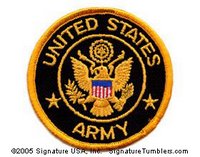 Well, that was it, I was now the property of the United States Army. We were then lead out of the room and broken down into smaller groups depending where we were assigned. I was assigned to Fort Jackson in South Carolina, where ever that was. My group got on a bus for the ride to JFK airport in Queens. When our plane landed in Columbia South Carolina a few hours later, we were met by someone from the Army and put on another bus for the ride to Fort Jackson where the fun really started.
Well, that was it, I was now the property of the United States Army. We were then lead out of the room and broken down into smaller groups depending where we were assigned. I was assigned to Fort Jackson in South Carolina, where ever that was. My group got on a bus for the ride to JFK airport in Queens. When our plane landed in Columbia South Carolina a few hours later, we were met by someone from the Army and put on another bus for the ride to Fort Jackson where the fun really started.
As soon as the bus pulled to a stop in front of the Reception Center, the meanest man I’ve ever come in contact with up to that point in my young life, jumps on the bus and starts yelling and screaming orders. “OFF THE BUS! DOUBLE TIME! LINE UP!" and all kind of crap like that. I spent one week at the reception center where we were given haircuts, tested a lot and were issued our uniforms. Then it was off to 8 weeks of basic training (where I met much more mean men). Next it was 8 weeks of Advanced Individual Training (AIT) not to far from where I took basic training (the men were a lot less mean here, but not nice by a long shot) where we were actually taught to be infantryman. I graduated from AIT with the rank of PFC, issued my orders for Vietnam and then given 30 days leave.
I spent one week at the reception center where we were given haircuts, tested a lot and were issued our uniforms. Then it was off to 8 weeks of basic training (where I met much more mean men). Next it was 8 weeks of Advanced Individual Training (AIT) not to far from where I took basic training (the men were a lot less mean here, but not nice by a long shot) where we were actually taught to be infantryman. I graduated from AIT with the rank of PFC, issued my orders for Vietnam and then given 30 days leave.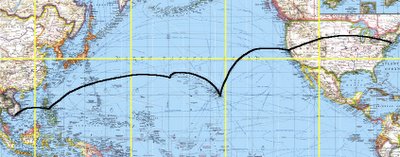 When my leave was over I caught a plane out of JFK airport in Queens bound for San Francisco California. I spent one night in a hotel room crammed in with about 8 other guys. I slept on the floor that night. The next morning I reported to the Oakland Army Terminal to begin my processing for deployment to Vietnam. I spent a few days in Oakland before getting my orders and then boarded another bus ride to the airport where we boarded a Flying Tiger Airlines plane and headed out across the Pacific on a 25 hour plane ride.
When my leave was over I caught a plane out of JFK airport in Queens bound for San Francisco California. I spent one night in a hotel room crammed in with about 8 other guys. I slept on the floor that night. The next morning I reported to the Oakland Army Terminal to begin my processing for deployment to Vietnam. I spent a few days in Oakland before getting my orders and then boarded another bus ride to the airport where we boarded a Flying Tiger Airlines plane and headed out across the Pacific on a 25 hour plane ride.
Our first stop was in Hawaii where they refueled and changed crews. We were sent to a deserted terminal while this happened, where they could keep an eye on us. When we got back on the plane, attendance was taken and one guy had bailed. Next stop was Midway Island for refueling. Midway is literally just an airstrip in the middle of a lot of small islands. We were suppose to stop in Guam next, but a typhoon diverted us to the Philippines instead. Here they refueled and changed flight crews. The whole time up to now, we flew with the sun in daylight, but the rest of the way was in the dark.
Things got pretty quite on this last leg of our journey because reality was setting in fast. I did manage to sleep a little, but mostly I just did a lot of thinking and trying to imagine what was in store. Once over Vietnam, the stewardess announced we were over the country and to wake up and get ready for landing. I remember looking out the window; I had a window seat, and seeing the vast darkness and every once in a while, a small point of light.
It wasn’t long before we were landing at Bien Hoa airbase in Vietnam which about 20 miles northeast of Saigon. The date was October 6, 1968 somewhere around 11:00 at night if I remember correctly. Just before getting off the plane, the flight crew thanked us for flying Flying Tiger Airlines and said something like “We hope to see all of you back with us in a year for the ride home”. We all looked at each other wondering which of us here wouldn’t make that flight back to the "World".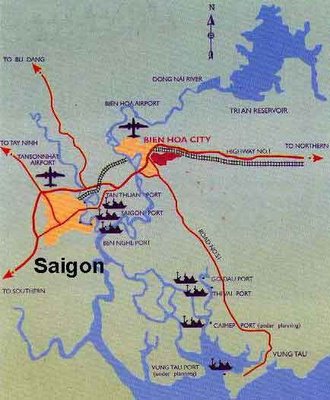 Bien Hoa Air Base was located 20 mi (30 km) NE of Saigon and near the infamous LBJ (Long Bien jail), which was the in-country military prison compound. Bien Hoa was also a huge munitions storage area. The base itself was upgraded from an old French post, and still had many of the old French buildings and small concrete bunkers scattered around the perimeter.
Bien Hoa Air Base was located 20 mi (30 km) NE of Saigon and near the infamous LBJ (Long Bien jail), which was the in-country military prison compound. Bien Hoa was also a huge munitions storage area. The base itself was upgraded from an old French post, and still had many of the old French buildings and small concrete bunkers scattered around the perimeter.
Sunday, March 26, 2006
Chapter 1: Drafted - May 6, 1968
Posted by BTExpress at 4:30 PM 5 comments
Saturday, March 25, 2006
Chapter 2: My On the Job Training Starts
Bien Hoa Airbase
http://www.vhpamuseum.org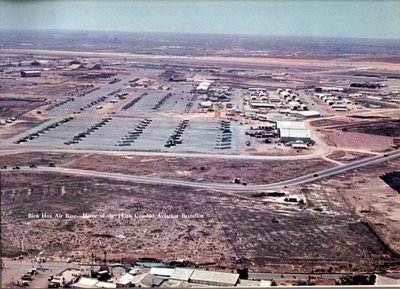
When the door of the plane was opened, we disembarked and began walking down the stairs to the tarmac. We went from the comfortable air-conditioned plane into the very hot, muggy, oppressive heat and became instantly drenched in sweat. The air was thick with so many new smells and sounds. There were the never-ending sounds of jets and choppers taking off and landing and the trucks and jeeps that were always on the move. There were so many new smells permeating the air but the one I remember most, the one smell that these some 37 years later instantly brings me back to that time, was the smell of diesel fuel. To this day, whenever I catch a whiff of diesel, I am instantly taken back to that time and transformed into that young soldier again.
http://www.gingerb.com
We were walking toward a building still in awe of what was all around us, when all of a sudden we heard an explosion, then another. Someone started yelling, “Get inside, get inside! Double time, double time!" We were rushed inside the building to a holding area. “OMG! What the fuck is happening?” I said to no one in particular as I ran for the building. Once inside, I saw a lot of people just going about their business like nothing was happening. No one was panicking, its as if no one even knew what was going on outside.
“Okay, calm down!” someone in green jungle fatigues yells out. “It’s over now, so calm down!” Sure enough, it was over, it ended as quickly as it began. The man in the fatigues explained that the airport had been under attack by rockets, that these kinds of attacks happened almost everyday, sometimes more than once. “You’ll get used to it,” he said. "Yeah, right", I thought, "I’ll never get used to that." Little did I know that really I would get used to it just like he said we would.
Off to one side in this holding area was a group of men that were waiting to catch the plane we just got off. They made through the year and now where going home. I remember thinking, would I make it back here in a year to catch that flight back? No time to think, time for another bus ride.
90th Replacement Center at Long Binh
http://saito56.blogster.com/ They took us outside where we boarded some more buses. These had screens over all the windows just in case someone tried to throw a hand grenade or something like that through one of them. The bus took us to the 90th Replacement Center in Long Binh where we went through in processing that lasted most of the night. We were assigned a bunk to catch a little sleep and were up early to eat breakfast and then stand in formation. Formation was held a couple of times a day to assign us to our units. I was assigned to the 25th Infantry Division at Cu Chi.
They took us outside where we boarded some more buses. These had screens over all the windows just in case someone tried to throw a hand grenade or something like that through one of them. The bus took us to the 90th Replacement Center in Long Binh where we went through in processing that lasted most of the night. We were assigned a bunk to catch a little sleep and were up early to eat breakfast and then stand in formation. Formation was held a couple of times a day to assign us to our units. I was assigned to the 25th Infantry Division at Cu Chi.
When my name was called, I was put on a C-130 cargo plane for the flight to the base camp in Cu Chi. It was like a small city. It had every type of facility there was in small cities; swimming pools, bars, slot machines in the bars, a hospital, stores and even saunas. I remember thinking why in the world would they have saunas in such a hot, muggy place? "(massages,hee hee!)
 I spent a week in Cu Chi going through in-processing and for some specialized training. This training was to teach us the things we needed to know that were not taught in basic training and AIT, like standing "real" guard duty and crawling through a tunnel. After that week at Cu Chi, I was assigned to the 2nd platoon, Bravo Company, 2nd Battalion, 12 Infantry, 25th Infantry Division; B 2/12 as they called it. A group of us got on a supply chopper for the flight to Fire Support Base Pershing, eight miles northwest of Cu Chi in the middle of some rice paddies somewhere.
I spent a week in Cu Chi going through in-processing and for some specialized training. This training was to teach us the things we needed to know that were not taught in basic training and AIT, like standing "real" guard duty and crawling through a tunnel. After that week at Cu Chi, I was assigned to the 2nd platoon, Bravo Company, 2nd Battalion, 12 Infantry, 25th Infantry Division; B 2/12 as they called it. A group of us got on a supply chopper for the flight to Fire Support Base Pershing, eight miles northwest of Cu Chi in the middle of some rice paddies somewhere.FSB Pershing was a battalion size base camp with four companies of infantry and an artillery and mortar battery. I wasn't at Pershing very long, about a week or so, so I didn't see very much of it. Here are a few pictures I found on the internet at http://www.212veterans.org.
Landing Zone Outside FSB Pershing
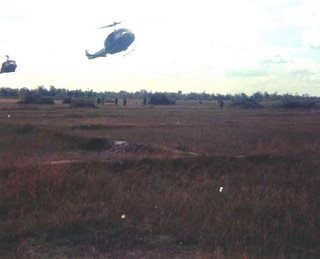
View of FSB Pershing
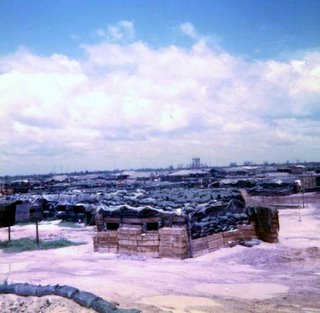
105mm Howitzer
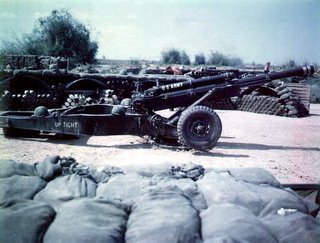
4 1/2 Inch Mortar
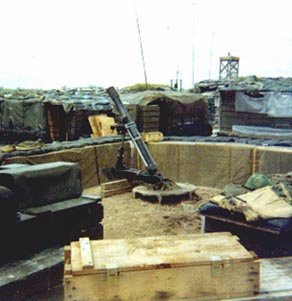
Mess Tent
http://www.gingerb.com
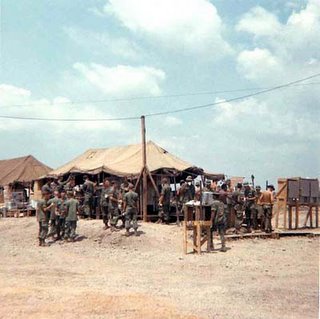
 Just before dark that first night, I was sent over to man a bunker, pretty much like the one in the this picture. As you can see, bunkers are really nothing more that a pile of sandbags with a small doorway and a few small holes to look out of. The bunker I was sent to, was usually manned by a few guys in another platoon, but they were sent out on a night ambush patrol that night. There was no one else in it at the time. I was told someone else would be over in a little while and we were to take turns keeping watch that night. That's how every night was, you take turns sleeping and stand watch.
Just before dark that first night, I was sent over to man a bunker, pretty much like the one in the this picture. As you can see, bunkers are really nothing more that a pile of sandbags with a small doorway and a few small holes to look out of. The bunker I was sent to, was usually manned by a few guys in another platoon, but they were sent out on a night ambush patrol that night. There was no one else in it at the time. I was told someone else would be over in a little while and we were to take turns keeping watch that night. That's how every night was, you take turns sleeping and stand watch.Now picture this, here I am on my first night out in the field, about a million miles from home, in only God knows where, inside a pile of sandbags in total darkness, staring out through a small hole in the front of this pile of sandbags. Since this my first night out in the field, I had no idea what to expect. I was truly scared to death.
Not long goes by and there was a loud explosion somewhere behind my bunker. Next thing I know, flares are going off in the sky lighting the entire area of the perimeter up to the woods.
 I scan the horizon searching for the enemy but didn't see any. Then there's another explosion; I’m practically shitting in my pants about now. Just then, someone dashes inside the bunker. Thank God, I’m not alone anymore. I look over quickly at the guy, but don’t see him carrying a weapon.
I scan the horizon searching for the enemy but didn't see any. Then there's another explosion; I’m practically shitting in my pants about now. Just then, someone dashes inside the bunker. Thank God, I’m not alone anymore. I look over quickly at the guy, but don’t see him carrying a weapon."Where’s your weapon?”
“I don’t carry one, I’m a medic.”
Oh, that’s great, this guy has no weapon. But then I thought, “Oh well, if I get wounded at least there’s a medic close by."
I look back outside through that little hole in the front of the bunker and Doc looks out of the second little hole. We keep our eyes glued to those little the holes. It all stopped after about 4 or 5 explosions.
It wasn’t very long before I heard a helicopter land in the landing zone in the picture above. I was to find out the next day, that the chopper was a medivac and the explosions I heard were from a mortar attack. Someone came by a few minutes later to see if we were alright. He also brought a radio and told us that about every half-hour, someone would call our position and we were to respond with “Sitrap negative”, meaning no trouble, or “Sitrap positive” if there was any. Then he leaves us. The enemy never did attack that night, and the rest of the night it was quiet.
While I was at Pershing that short time, these kinds of attacks happened pretty much every night, but with mortars that never even hit inside the base camp. The enemy would guess the range from somewhere beyond the tree line and fire a few shells in our general direction, always landing out in the rice paddies somewhere. After a few days, I got used to them like the guy in fatigues at Bien Hoa said we would and just learned to accept them as a fact of life over there.
Posted by BTExpress at 4:38 PM 1 comments
Friday, March 24, 2006
Chapter 3: The Memorial Service
Just after dawn the next morning, the guys that usually man the bunker I was in, got back and I went back to the bunker I was assigned to yesterday. Everyone was getting up and getting ready for the day. I had absolutely no clue what to do, no clue at all. I guess the “veterans” saw my look of confusion and took me under their wings and showed me the ropes. We washed up and then went to breakfast.
Mess Tent
http://www.gingerb.com During breakfast we found out that there were a couple of guys killed in the attack last night, I think three, and a few wounded. They said one guy died while he was taking a leak and when the first rocket hit, it killed him. They also told us there was a mandatory memorial service after chow, not like we had to be force to attend.
During breakfast we found out that there were a couple of guys killed in the attack last night, I think three, and a few wounded. They said one guy died while he was taking a leak and when the first rocket hit, it killed him. They also told us there was a mandatory memorial service after chow, not like we had to be force to attend.
http://www.pieceuniquegallery.com
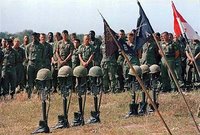 The service was really a frightening thing to experience for me, something like going to your first funeral when you’re young. You know, one-minute you’re here and the next minute your not. The only difference with being in war and being home is that in war, your “family” replaces you pretty easily, but at home, it’s not that simple.
The service was really a frightening thing to experience for me, something like going to your first funeral when you’re young. You know, one-minute you’re here and the next minute your not. The only difference with being in war and being home is that in war, your “family” replaces you pretty easily, but at home, it’s not that simple.Watching the memorial service made me wonder whom I had replaced and if they would be holding a memorial service for me someday. Someone told that first day, that the rifle I was issued was owned by a guy that was killed before he even got to use it. I just laughed that off because I figured how could anyone tell the difference between all those M-16s. But then I learned that not very long before I got there, a couple weeks maybe, our unit had a lot of casualties and was short handed and that’s why I was sent there, they were short handed.
After the service I was introduced to the guys in my platoon, I wish I could remember some of their names, but after all these years, I just can’t remember them. I have some of them written down somewhere, I'll see if I can find them. I was was also given my assignment. I was as one of the two ammo bearers for the guy that carried the M-60 machine gun. As ammo bearer, I carried a lot of stuff. I carried 400 rounds for the M-60, the ammo magazines for my M-16, a couple of hand grenades and a couple smoke grenades. I also carried an M-72 LAW. Wait, that’s not all. There were also at least 2 canteens of water, more if you could find an extra canteen, a first aid bandage, C-rations and cigarettes. (I think practically everyone smoked) I looked something like the guy in the pictures except I was not this tidy and no jewelry, well except for dog tags. Jewelry could get you killed.
As ammo bearer, I was to stay close to the machine gunner while out on patrol, usually right behind him. Typically, when there was any action, the machine gunner went over to where the fire came from and you know what this meant, I had to be right with him. There was really only one time that that happened but I’ll leave that story for another chapter as that didn’t happen while I was at Pershing.
Posted by BTExpress at 4:44 PM 0 comments
Thursday, March 23, 2006
Chapter 4: The Typical Day
Before I get into more of my adventures, I thought I would give you an idea what a typical 24 hour day was like for me.
Most days and nights were uneventful. We’d get up, eat breakfast, walked patrol during the day, stand watch for a couple of hours at night and every few nights, go out on night ambush. Well, except for the almost nightly rockets or mortars while I was at FSB Pershing, but I already told you about that.
First let me tell you about a patrol.
Pa·trol n 1: a detachment used for security or reconnaissance 2: the activity of going around or through an area at regular intervals for security purposes 3: a group that goes through a region at regular intervals for the purpose of security v : maintain the security of by carrying out a control [syn: police]
We’d get up not too long after it got light out, clean up, eat breakfast and get a briefing on what we were going to do that day. Then we’d pack up a day’s worth of the supplies we’d need and then head off on patrol. We’d usually just start walking the patrol, but sometimes we’d have to patrol somewhere too far away to walk to, because enemy activity was observed in an area or something like that.. In that case, we would taken by helicopter and then be dropped off and then we’d walk patrol.
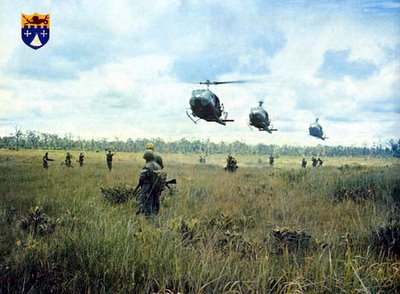
Patrol consisted typically of walking around searching for things and looking at stuff (search and destroy). We’d walk for awhile, stop for a short break and then walk some more until it was time for lunch. Lunch was always a picnic of the always delicious box of C rations. After lunch we’d walk around somemore, take another short and then head back to base camp. Patrol kind of reminded me of exploring the woods and swamps like I did growing up in Florida except in Florida I didn’t carry a rifle and all that other stuff I described in the last chapter.
http://storiesfromvietnam.com

http://www.212veterans.org/

Once back in camp, we’d spend the time getting cleaned up, cleaning our weapons and writing letters and stuff like that until dinner. Dinner was always really very good (but then I liked cafeteria food in school so maybe I’m not the best judge). It was always hot and there was plenty of it. We always each got a quart of milk to drink. After dinner we’d retire to our bunkers and hang out before bedtime.
http://www.212veterans.org/
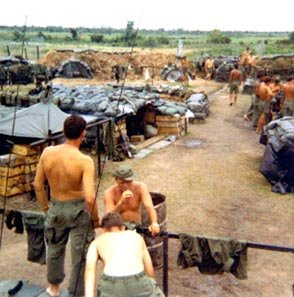
Then there was watch.
Watch v. watched, watch·ing, watch·es v. intr. 1. To look or observe attentively or carefully; be closely observant: watching for trail markers. 2. To look and wait expectantly or in anticipation: watch for an opportunity. 3. To act as a spectator; look on: stood by the road and watched. 4. To stay awake at night while serving as a guard, sentinel, or watcher. 5. To stay alert as a devotional or religious exercise; keep vigil.
When it started to get dark, we took turns standing watch for the night. First watch was always the best because once it was over, you got uninterrupted sleep for the rest of the night. The last watch sucked the most because you had to get up two hours early. Not much else to say about standing watch except it was usually boring and hopefully no one fell asleep while on watch.
My least favorite thing to do was go out on night ambush.
Am·bush n. 1. The act of lying in wait to attack by surprise. 2. A sudden attack made from a concealed position. 3. a. Those hiding in order to attack by surprise. b. The hiding place used for this. 4. A hidden peril or trap.
I hated night ambush more than anything we did. Every few days after we got back from patrol, one of the squads in our platoon (a squad is about 10-12 men), would go out on night ambush. After supper, we’d pack our poncho liner (sort of a small comforter used like a blanket to keep warm), restock anything we’d used during the day like water, ammo, etc, just not food, and head off to set up an ambush.
Officially we’d go to the assigned place, set up a few claymore mines all around us and wait for the bad guys to come by. If they did, we’d shoot at them. Unofficially, we’d usually just go to one of our favorite hiding spots, which was anywhere where we hoped the bad guys would not show up. Then we’d set up the claymores and for the rest of the night be real quiet until it got light out. I was told to never shoot first if I saw anyone. That way, hopefully they’d not see us and just walk on by. The reason we did this was because you never knew if the guys you saw were just a small patrol or the point for a battalion of NVA soldiers. See why we stayed quiet? We’d take turns sleeping and then just after daybreak we’d pack up and go back to camp and spend the rest of the day off duty doing pretty much what ever you wanted to do.
Look, I know I’ve over simplified this whole thing and many combat veterans will find fault with my descriptions, but that really was pretty much what it had been like most days for me. Mixed in amongst those days were the days that I’d wished had never come or would hurry and be over. The days I feared for my life and the lives of those around me. The days I trudged through the rice paddies in the muck and mire. The days I baked in the hot sun or shivered in the cold nights. The days and nights the rain drenched me. The days I was shot at and the days someone was wounded or killed. There were also a lot of good days too. Like the day I took a trip into the division base camp at Cu Chi for the fake tooth ache and the day we bought some scotch from a local and drank it with grape soda. Those are the days I will try to relive for you in the coming chapters.
Posted by BTExpress at 4:46 PM 1 comments
Wednesday, March 22, 2006
Chapter 5: Some Miscellaneous Stuff at FSB Pershing
I didn’t really know where these next few things fit into my stories while I was at Pershing, so I just figured I would put them together in this post.
Latrine Duty
When we didn’t have to walk patrol during the day, we just hung around the base camp and tended to daily chores. Things like laundry, writing letters, reading, cleaning our weapons, things like that. There was also one job that everyone took turns doing but didn’t enjoy for obvious reasons, burning shit. Yeah, you read this right, burning shit. The first time I had to do it, I just helped and someone showed me what to do.
www.landscaper.net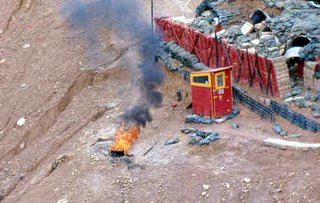 The latrines were like a typical outhouse with half a 55-gallon drum under the seat to catch, well, you know, shit. When the drum was near full, some lucky guy (since I was new in town, this times it was me) would get to go behind the latrine and drag the drum out and off to one side, the downwind side hopefully. Then he’d pour a little diesel fuel into the drum and set it on fire.
The latrines were like a typical outhouse with half a 55-gallon drum under the seat to catch, well, you know, shit. When the drum was near full, some lucky guy (since I was new in town, this times it was me) would get to go behind the latrine and drag the drum out and off to one side, the downwind side hopefully. Then he’d pour a little diesel fuel into the drum and set it on fire.
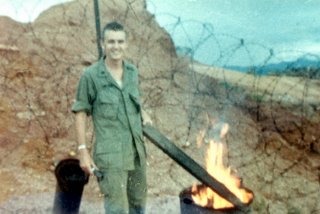 As the contents of the 55-gallon drum burned down, I had to stir it every so often so that all of the contents burned. That’s what the guy in the picture is doing. Being the new guy in town, I got the honors of stiring the shit this time.
As the contents of the 55-gallon drum burned down, I had to stir it every so often so that all of the contents burned. That’s what the guy in the picture is doing. Being the new guy in town, I got the honors of stiring the shit this time.Please take note of the black pipe stuck in the ground to the left of the fellow in the picture. That pipe is what was called a “Piss Tube”. I guess I don’t have to explain what that was for?
Sleeping Arrangements
Most of us slept in the bunkers. Typically the floor was covered in wood or a mat of some kind. It’s not very comfortable, but you were sheltered and protected in case we took fire. Each of us was also issued something called a Shelter Half.
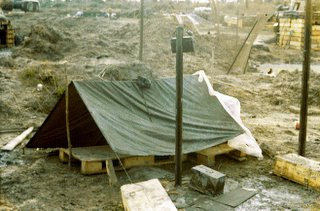 When you put two of them together, you got a small tent just big enough for two people. A lot of guys got together and set these up. One of the guys in my bunker and I decided one day to do just that. We set it up behind our squad’s bunkers in case we had to take cover quickly. We found some wood for the floor and slept on that. This was a lot better than sleeping on the dirt floor in the bunker. It looked something like this.
When you put two of them together, you got a small tent just big enough for two people. A lot of guys got together and set these up. One of the guys in my bunker and I decided one day to do just that. We set it up behind our squad’s bunkers in case we had to take cover quickly. We found some wood for the floor and slept on that. This was a lot better than sleeping on the dirt floor in the bunker. It looked something like this.One night when we were sleeping, someone calls out “IN COMING!” I knew what that meant, our nightly mortar attack. I grabbed my M-16, jumped up and out of the tent and dashed over into the first bunker I saw, which by the way wasn’t mine. I landed right in a friggin pool of water. Some assholes decided they wanted to have more headroom in the bunker, so they dug out the floor. Since it was still the rainy season, the floor filled up with muddy water. I sat in the water cursing under my breath waiting for the mortars to stop. They stopped in a minute of so and had landed harmlessly out in the rice paddies. I climbed out of the bunker bitching and moaning, all pissed that I was now soaked with muddy water. I was pissed, but everyone else though it was funny as hell and laughed their ass off.
Claymores
Out in front of each bunker we set up several claymore mines. They were nasty little things that could inflict a lot of damage over a pretty wide area.
The M18 Claymore antipersonnel weapon is a weapon often used by many countries around the world, named after the large Scottish sword. The Claymore is designed to fire steel balls (shrapnel) out to about 100 meters across a 60° arc in front of the device, which stands just off the ground. It is designed primarily to be used in ambushes and as an anti-infiltration device against enemy infantry, however it is also of some use against soft-skinned vehicles.
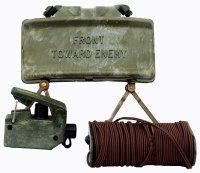
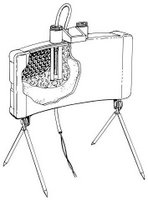
Yes, it really did say “Front Toward Enemy”
One day I was assigned to set up claymores out in front of some bunkers. I remembered how to do it from training so it wasn’t difficult to do.
* Place the mine on the ground
* Aim the mine using the sighting slit
* Firmly press the support legs into the ground, rechecking the aim.
* Lay wire from firing position to the mine.
* Insert blasting cap into either detonator well and secure with the shipping plug.
* With the "Safety" in the "Off" position, insert plug of wire directly into M57 Firing Device. (Boy, did I soon learn that this was an important step)
When you want to fire it:
* Depress the handle (squeeze the device) sharply. This will send an electrical current to the blasting cap, causing it to detonate. The detonation of the cap, in turn, will cause the main charge of C-4 to detonate, sending the steel fragments into the opposing personnel.
When I finished setting up the claymores, I got the sergeant so he could check how I did. He walked out in front of the bunkers so he could see them and he said everything looked fine. On his way beck to where I was, his foot caught the wire to one of the claymores pulling the firing devise off the bunker. When the firing devise hit the ground, the claymore exploded. It looked something like this.
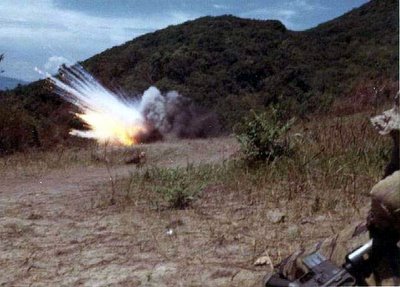 We all jumped sky high but the sergeant froze in his tracks. He turned and looked at me with a look that could kill and walked over to the firing device. He picked it up and showed it to me. I had forgotten to make sure the safety was on.
We all jumped sky high but the sergeant froze in his tracks. He turned and looked at me with a look that could kill and walked over to the firing device. He picked it up and showed it to me. I had forgotten to make sure the safety was on.That little explosion caused quite a ruckus at Pershing that day. The lieutenant and sergeant were called up to speak with the company commander. When they got back I was called over to speak to them and caught a little bit of hell for my incompetence, but I didn't really get in trouble. Just a little yelling and a lecture about keeping my mind on what I was doing, always be aware of what I’m doing and above all, check to make sure the safety on the firing device is ON the next time.
By the way, someone else checked the rest of the firing devices to make sure the safeties were set. I guess the sergeant thought that was probably best for everyone.
Posted by BTExpress at 4:48 PM 3 comments
Tuesday, March 21, 2006
Chapter 6: Hot LZ
Landing Zone
From Wikipedia, the free encyclopedia.
A Landing Zone or "LZ" is a military term for any area where aircraft land.
In the American military a landing zone is the actual point where aircraft land, (equivalent to the commonwealth landing point.)
In commonwealth militaries a landing zone is the cartographic, (numeric,) zone in which the landing is going to take place, (i.e. the valley.) Landing area is the area in which the landing is going to take place (i.e. the field where the aircraft are to land.) Landing point is the actual point on which aircraft are going to land (i.e. a point of the field.) Each aircraft has a different landing point.
Landing areas are most commonly marked by coloured smoke. The standard procedure is for those at the landing area to pop smoke and say so over the radio. The pilot says when smoke is seen and what colour the smoke is. Those on the ground then respond with what colour the smoke should be. Smoke of a different colour can mean the landing area has been compromised, and the pilot usually has the authority to cancel a landing.
A hot landing zone, or Hot LZ, is the place you never want to hear you are going. Hot means the landing zone is occupied by the Vietcong or NVA who will be shooting at you while you are landing or when you land.
http://www.25thida.com
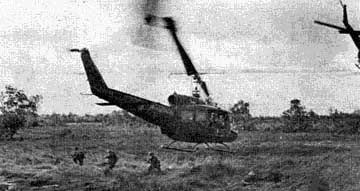 SCATTER, AND QUICKLY! Tropic Lightning soldiers of the 1st Brigade charge out of their choppers into the hot landing zone, even as the Hueys are on their way out.
SCATTER, AND QUICKLY! Tropic Lightning soldiers of the 1st Brigade charge out of their choppers into the hot landing zone, even as the Hueys are on their way out.Late one afternoon, our company was on our way back to FSB Pershing after an uneventful day on patrol. Right outside the wire around Pershing, we were told to hold up. The officers and NCOs were called together and briefed about something. When they were finished talking, we were briefed. It seems that some North Vietnamese Army soldiers (NVA) (I forget how many) were spotted and we were being sent back out to go after them. One platoon would be sent in first and radio back with what we would be encountering. If they made contact the rest of us would be sent in.
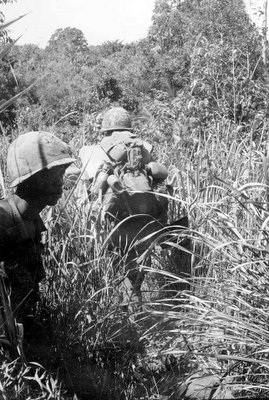 They also told us that we would be landing in and area covered with elephant grass. I knew what that was and didn’t look forward to having to fight in that. (Here is what elephant grass looks like.) They told us to take a break and we would be resupplied before back heading out. We settled down and supplies were brought out to us from Pershing. Things like water, food, hand grenades, smoke grenades, claymores, a lot of extra ammo, even cigarettes. We received enough supplies for a day or two. I wondered why they were giving us so much, but the guys explained that this was normal for something like this just in case we had to stay.
They also told us that we would be landing in and area covered with elephant grass. I knew what that was and didn’t look forward to having to fight in that. (Here is what elephant grass looks like.) They told us to take a break and we would be resupplied before back heading out. We settled down and supplies were brought out to us from Pershing. Things like water, food, hand grenades, smoke grenades, claymores, a lot of extra ammo, even cigarettes. We received enough supplies for a day or two. I wondered why they were giving us so much, but the guys explained that this was normal for something like this just in case we had to stay.A lot of things ran through my mind while we waited to go, which I’ve long since forgotten, but one thing you can be sure of was that I was scared and that everyone was scared. They told me that being scared was normal even for the guys that had been through this before, but once things got started, I just needed to remember what I was trained to do and I would be okay. I also remember thinking that this was it. That this was going to be the first time I would come face to face with the enemy in battle. I knew it was impossible to spend an entire year in Vietnam without this happening. It wasn’t exactly what I wanted to do, but that’s what I was here for. I pretty much accepted the fact I would be going into battle and busied myself with packing up the supplies.
It wasn’t long before the choppers came in and picked up the first platoon to go hit the LZ, luckily we were not in the first group. After they took off, we gathered around the radio operator (RTO) to listen to what was going on. First they called in air strikes on the area to hopefully soften things up. When the air strikes were called off, the choppers were sent in with the troops. When they landed we heard exactly what we wanted to hear, “No resistance!” I remember feeling such a relief.
They patrolled the area for about a ½ hour or so but found nothing. It looked like once the enemy knew they were spotted, they took off or hide. One thing about the NVA and Vietcong, other than snipers, was they never fought unless you took them by surprise and they had no choice except to fight, or they were sure they had you out numbered and out gunned. I guess this time it was the latter, which was just fine with me.
Landing in a Hot LZ
There was one time we actually landed in a Hot LZ. We were picked up one morning by choppers and flown to another area for our patrol. I should remind you I liked to sit on the floor right behind the pilot. Being in that spot always meant I was one of the first ones off the chopper when it touched down and one of the last ones on when it took off. What can I tell you, I liked the view sitting there with my feet hanging out the door?
On our way in to the LZ, one of the choppers reported that they were taking on small arms fire and that the LZ would be hot. We were also told that since it was hot, the choppers wouldn’t be touching down, but hovering a couple of feet off the ground so they could take off quick. We would have to jump the rest of the way.
The choppers circled the LZ and the door gunners (M-60 machine gunners on each side of the chopper) fired into the LZ all the way down.
Once we got close to the ground, we hopped off the chopper and ran over to the berm surrounding the rice paddies, we got down and took cover. We fired a few rounds for effect, but none was returned, which made me very happy.
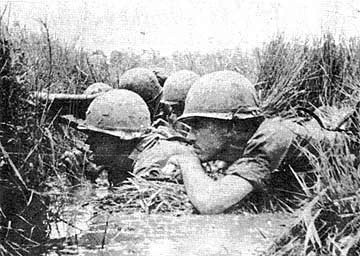
One of the guys next to me asked me if I was okay.
“Yeah, why?”
“A round hit right between your legs just as you hit the ground.”
I was pumped with adrenaline so I had to actually stop for a second to see if I could feel if I’d been shot; nothing.
“No, I’m fine.”
“That was close, your lucky.”
“Yeah.”
I don’t remember anything specific about the rest of the day, but as far as I’m concerned, that was enough for one day.
Posted by BTExpress at 4:50 PM 0 comments
Monday, March 20, 2006
Chapter 7: We're Moved to FSB Stuart
After about a week or so at FSB Pershing, our company was reassigned to FSB Stuart to guard the bridge over a small river on Highway 1, one of the main highways in that area. FSB Stuart was just outside of the village of Trang Bang about 9 miles from Cu Chi.
STUART, FSB (or) FSB Stuart III [Hieu Thien map] - XT 499197
Stuart III: The fire support base at the Highway 1 bridge near Trang Bang. Stuart III is the FSB most commonly refered to as "Stuart." Also misspelled "FSB Stewart." 2/12th base late 1968 to early 1970.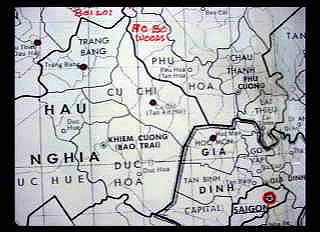 TRANG BANG - vic XT4919
TRANG BANG - vic XT4919
Trang Bang – pronounced just as it's spelled – was a market center for the surrounding coutryside. The 2/12th area of operations from late 1968 to February 1970.
No chopper ride this time, we had to hike about six miles to FSB Stuart. It was a particularly hot and humid day and some where along the way I passed out from heat exhaustion. I couldn’t be revived so they called in a medivac chopper to take me to the 12th Evacuation Hospital at Cu Chi to recover.
I spent the night in the hospital receiving fluids by IV and the next morning was discharged from the hospital and sent over to HQ so I could get back to my unit. They put me on a supply truck with a couple of other guys and supplies for my unit. We were told that we were to keep an eye out for anything suspicious. The ride was uneventful but somewhat scary for me as I’d only been in country for about two weeks at this point and had never done anything like this before.
When I got to FSB Stuart, I went over to the command bunker and reported in and then was sent over to the bunkers where my platoon was assigned. Here are a few shots of Stuart.
When the squad that normally manned this bunker went out on patrol during the day, this was the place everyone wanted to be assigned. They had this place fixed up with all kinds of great stuff.
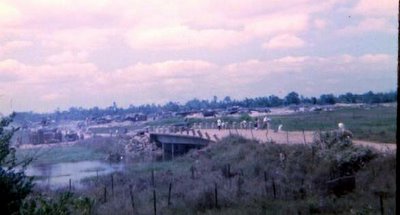 This is a View of FSB Stuart Looking From The Other Side of the Bridge. The Bridge Bunker is on the Left
This is a View of FSB Stuart Looking From The Other Side of the Bridge. The Bridge Bunker is on the Left Look at the soldier standing next to the gun. Now you can get an idea of actually how big these monsters are. There were two of these big guns in the center of the FSB and when they were fired, the noise was earth shaking, literally. So before they fired them, they called out a warning.
Look at the soldier standing next to the gun. Now you can get an idea of actually how big these monsters are. There were two of these big guns in the center of the FSB and when they were fired, the noise was earth shaking, literally. So before they fired them, they called out a warning.I left the command bunker, found my squad and caught some harmless kidding about not being able to make the hike, but that was to be expected. I ask them where I slept. They laughed and point over to what looks like a long rounded pile of sandbags. It was about four feet high, four feet wide and about eight feet long. There was a little opening at one end to crawl in to. I walk over, get down on my knees and look inside. It was great, well great compared to a bunker. There were some pieces of wood laid down for a floor, a stretcher to sleep on and a box for a small table at the head end. This was a lot better than sleeping on a mat on the floor of the bunker. I crawled back out and thanked them for the accommodations. It was so funny to see their faces when they all took a look inside. It seems that none of them actually looked inside and just assumed it was a shitty place to sleep. I had offers to pay me to switch but didn’t accept the offers.
The FSB was laid out in a large circle surrounded by bunkers, razor wire and mines. In the center were the command bunker, the mess tent, a latrine, showers and those 12-inch guns. During the day, there were also a few a few tanks. They stayed out in the surrounding rice paddies at night around the bridge to help guard it, but during the day they came inside the FSB for supplies, showers, meals etc.
The road you see in the pictures was Highway 1. This view is very close to the exact view I had from my bunker. Highway 1 was the main road into Trang Bang and was loaded with traffic back and forth on the highway all day. There were always people trying to sell us things along the side of the road out in front of the FSB. You could buy pretty much whatever “luxuries” you needed that weren’t supplied to you. Liquor, marijuana filled cigarettes at $20 a carton (you supply the carton of regular cigarettes and they fill them with pot), pot at 50 cents an ounce, radios, ice and you could even get laid if you wanted. That would cost you 50 cents. The hooker would toss a mat down in the weeds. I never bought the services of a hooker, but I did buy a radio for $20. I still have the radio in the basement, but haven’t tried it for years so I don’t even know if it still works.
FSB Stuart was where I was assigned the rest of my time in Vietnam, which would only be about two more weeks at this point.
Posted by BTExpress at 4:52 PM 1 comments
Sunday, March 19, 2006
Chapter 8: Scouts, Dogs and Booby Traps
Kit Carson Scout
Many times when we went out on patrols from FSB STUART, a Kit Carson scout lead our patrols. Kit Carson scouts are former Viet Cong or North Vietnamese soldiers that were our guides and interpreters. He always walked point with one or two of the regular point men and because of his first hand knowledge of enemy tactics, was able to locate mines, booby traps, ambushes and snipers long before we ever could.
Dogs and Dog Handlers
Other times a dog handler and his German Shepherd would accompany us on patrols. The dog was great because he could smell trouble, literally. He could pick up the scent of the enemy and lead us right to them. We captured numerous VC because of both the Kit Carson scout and the dog.
Punji Pits
One day we were patrolling through a heavily wooded area around a village and the Kit Carson found a suspected VC hiding. He gave up without any difficulty. We made him walk point with the Kit Carson and our point man. We figured if he lead us into an ambush, he would be the first to go. As we walked along, the VC started pointing out a lot of freshly dug punji pits right on the trail we were following. Maybe he knew where they were because he dug them.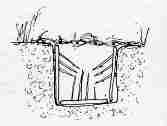 Punji pits like the ones he uncovered are extremely nasty booby traps. The simplest pit type was a hole about 20 to 30cm deep. The floor of this trap was then set with punji stakes, which could easily pierce the canvas and leather jungle boot. For added misery the spikes could be smeared with poison or human excrement to induce blood poisoning or worse. There were many variations, which allowed the spikes to attack the sides of the leg. This was particularly favored after the introduction of the reinforced-soled jungle boot.
Punji pits like the ones he uncovered are extremely nasty booby traps. The simplest pit type was a hole about 20 to 30cm deep. The floor of this trap was then set with punji stakes, which could easily pierce the canvas and leather jungle boot. For added misery the spikes could be smeared with poison or human excrement to induce blood poisoning or worse. There were many variations, which allowed the spikes to attack the sides of the leg. This was particularly favored after the introduction of the reinforced-soled jungle boot.
On another patrol one day, I stepped into a small punji pit. I felt like I was going to have a heart attack because I knew exactly what had happened. Fortunitly the bamboo stakes were old and rotten so they just crumbled when my foot and leg hit them. I didn't even get a splinter.
Trip Wires
Another booby trap I encountered was a trip wire. Trip wires were connected to all types of booby traps like the hand grenade in the picture below.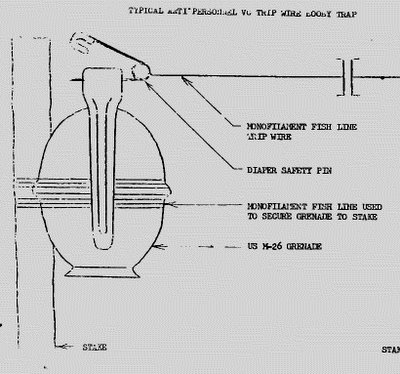
One day we were dropped off in the Ho Bo Woods for a “Reconnaissance In Force” (RIF) patrol with one other company. Enemy activity had been spotted so we were sent there to see if we could find them.
As you can see in the picture, the Ho Bo Woods weren't exactly what you would call woods any more. This area used to be a stronghold for the VC and NVA so the woods were leveled to eliminate hiding places.
While patrolling the area, my foot got caught on something. I looked down and saw it tangled in a wire. I froze and called out that I was tangled in a trip wire. Now you figured the guys would back up since there was a possibility of an explosion, but no, a couple of guys immediately came over to check it out. They followed the wire and discovered that in wasn’t connected to anything, that it was probably an old trip wire, or maybe just a piece of wire lying around. I spent a lot of time looking down after that.
Not a Booby Trap
Another day we were patrolling around one of the villages close to our FSB. We were walking on the berm that separated the rice paddies like the guys in the picture.
All of a sudden I fall straight down into a hole filled with water that was over my head. Since I was carrying all that equipment, I sunk like a rock. I reached up to try grab something to pull my self out and someone grabbed my hands and pulled me up. My head went right back into my helmet which was floating on the surface of the water. With some help, I climbed out of the hole. It seem that I had fallen into a small well that had overgrown with the grasses that grew on the berms. Since it was over grown, I didn’t see it. This incedent got quite a laugh from everyone.
Posted by BTExpress at 4:06 PM 9 comments

